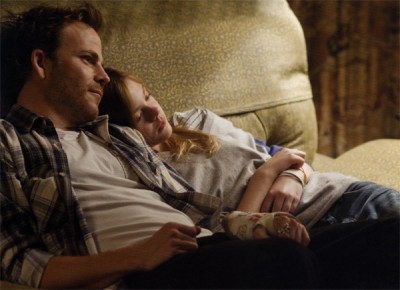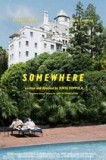| Reviews & Columns |
|
Reviews DVD TV on DVD Blu-ray 4K UHD International DVDs In Theaters Reviews by Studio Video Games Features Collector Series DVDs Easter Egg Database Interviews DVD Talk Radio Feature Articles Columns Anime Talk DVD Savant Horror DVDs The M.O.D. Squad Art House HD Talk Silent DVD
|
DVD Talk Forum |
|
|
| Resources |
|
DVD Price Search Customer Service #'s RCE Info Links |
|
Columns
|
|
|
Somewhere

In the opening scene of Sofia Coppola's Somewhere, a Ferrari roars across the screen, then around a race track, off-screen, and then back again. Over and over, through the frame, running the track in endless circles. The sequence isn't accidentally chosen; Coppola is using the movement of the car as a metaphor for the monotony present in the life of the driver, movie star Johnny Marco (Stephen Dorff). Trouble is, it's also representative of the film he inhabits. There is a fine line between making a film about a dull, humdrum life, and making a dull, humdrum film. Somewhere, unfortunately, does not quite manage to cross that line.
Coppola is taking a calculated risk with this project; it's not often that one sees this kind of detailed and unforgiving account of nothing happening. There's little dialogue in the opening scenes, and once words are spoken, they are not the expected ones--there are no proper introductions and no exposition per se; it is, to a great extent, like a movie overheard rather than created. Johnny Marco lives at the Chateau Marmont. He has a new film coming out. He does some publicity for it. There is another one coming up, so he goes down to the studio so the makeup guys can do some tests; he sits under the plaster molding, a blank mask, just breathing. There is a daughter, 11-year-old Cleo (Elle Fanning), and a mother who decides she needs some time away. Strippers and partygoers and syncophants come and go, not so much entering and leaving as blurring in and out of view.
The scenario unfolds less in scenes than in impressionistic sketches--charcoal rather than oil. Coppola's work has had these overtures towards tone poetry before; here, she pushes those lyrical interludes as far as they can go, to the primary action (or inaction). There is, to be sure, something to be said for this kind of narrative/anti-narrative daring, and some will be delighted by the film's rule-breaking. But a good chunk of the audience, even those who have admired her previous work, are going to find it unbearably tedious.
The trouble with responding to a picture like Somewhere with something less than the expected enthusiasm (it won the Venice Film Festival and has popped up on several year-end 10-best lists) is that its defenders assume that it's simply gone over the indifferent viewer's head. That's not the case here: Coppola's methodology is transparent to the point of obviousness. We are immersed in the emptiness of Johnny Marco's numbing existence, and then we see (in theory) the oasis of normalcy and connection represented by Cleo, a real person amid the mannequins and blow-up dolls. He sees it too, and responds, the soul is saved, etc.
But the payoff that we're waiting for never really arrives as forcefully as it must to compensate for the unsteady trip that we've taken, or to fulfill the catharsis that Coppola is preparing for. When Johnny breaks, yes, it is powerful. But it's not powerful enough; the scene comes up short, and so does Dorff's performance. He encompasses the grinning bad boy with ease, but doesn't give enough hints of anything happening inside. If Somewhere is a character study--and that's about the best explanation of it--I'm not sure we actually get a sense of who he is. This may be Dorff's fault, or it may be Coppola's; she has done, it seems, too thorough a job of making him an empty vessel. This may very well be the picture's fatal flaw.
Somewhere has its virtues--Fanning is wonderful, several of the scenes work within their specific moments, and it's gorgeous to look at. The cinematography is by Gus Van Sant's frequent collaborator Harris Savides, who is the clearest link to the film Somewhere is most reminiscent of: not, as many had anticipated, Coppola's previous hotel-daydream tale, Lost in Translation, but Van Sant's exhausting 2005 effort Last Days, which regarded another privileged star from a dramatically inert distance. Somewhere isn't nearly as irritating, but it is equally puzzling. If the delicate high-wire act had worked, the picture would have been a triumph. As it is, it's a failed, if noble, experiment.
Jason lives in New York. He holds an MA in Cultural Reporting and Criticism from NYU.
|
| Popular Reviews |
| Sponsored Links |
|
|
| Sponsored Links |
|
|
| Release List | Reviews | Shop | Newsletter | Forum | DVD Giveaways | Blu-Ray | Advertise |
|
Copyright 2024 DVDTalk.com All Rights Reserved. Legal Info, Privacy Policy, Terms of Use,
Manage Preferences,
Your Privacy Choices | |||||||











